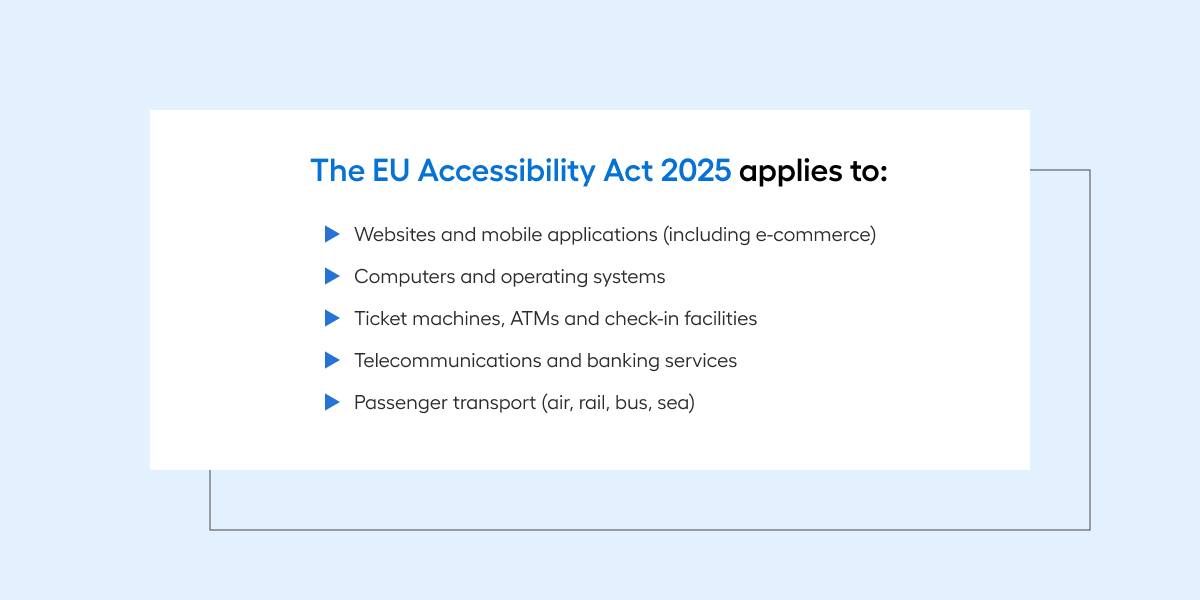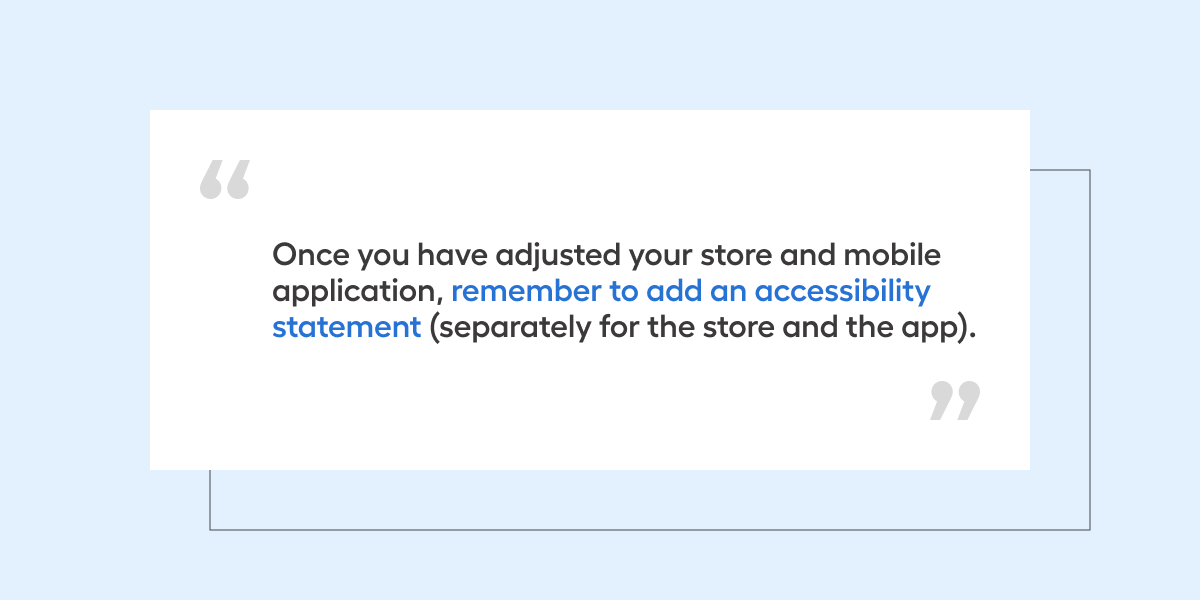Table of Contents:
- What is the EU Accessibility Act?
- What products and services does the EAA cover?
- How to prepare for the EU Accessibility Act 2025?
- Accessibility Statement
- Business Opportunities Related to the EAA
What is the EU Accessibility Act?
European Accessibility Act (EAA) is an EU directive aimed at improving access to key products and services for people with disabilities and the elderly.
The full implementation of the regulations is set for June 28, 2025, and entities offering products and services covered by the regulation (including online stores) will be required to meet specific accessibility standards.
What products and services does the EAA cover?
According to the directive, the requirements apply to, among others:
- Websites and mobile applications (including e-commerce),
- Computers and operating systems,
- Ticket machines, ATMs, and check-in devices,
- Telecommunication and banking services,
- Passenger transport (air, rail, bus, maritime),
- Consumer electronics, e-books, and audiovisual services.
For businesses, this means implementing unified accessibility standards in accordance with WCAG 2.1 AA and EN 301 549. Failure to meet these requirements may result in financial penalties and restricted access to the EU market.

Who is exempt from complying with the EAA?
The requirements and obligations of this directive do not apply to micro-enterprises. A "micro-enterprise" is defined as a company with fewer than 10 employees and an annual turnover not exceeding €2 million.
How to prepare for the EU Accessibility Act 2025?
Implementing the EAA regulations is a process that should begin now. Below is a list of key steps to effectively adapt your store to the directive's requirements.
Accessibility Audit
The first step is to conduct an accessibility audit, which includes areas such as:
- Identifying elements that do not comply with WCAG 2.1 AA,
- Analyzing keyboard navigation (especially form handling),
- Checking multimedia accessibility (videos should include subtitles, and both audio and video should have full transcriptions),
- Verifying color contrast (use WebAIM Contrast Checker),
- Ensuring readability of fonts and their sizes,
- Checking for alternative image descriptions (ALT attributes should be added),
- Verifying header hierarchy (correct order: H1, H2, H3, H4, H5, H6),
- Providing descriptive link texts (avoid vague "Click here" and use more informative phrases like "Go to the product page").
Fortunately, there are tools that make accessibility testing much easier. One of them is BrowserStack's Accessibility Testing module. This solution helps automate testing, reducing manual workload for your team.
Mobile App Adaptation
The directive applies not only to web browsers but also to mobile applications. If your store includes an app, it must also comply with the new regulations.
All interactive elements in the app should meet accessibility standards. Remember to test across different screen resolutions.

Accessibility Statement
Once you’ve adapted your online store and mobile app to accessibility standards, it’s worth considering adding an accessibility statement for each (one for the store and one for the app). While it’s not a legal requirement for eCommerce (as it applies to public entities), implementing such a statement is a good practice that demonstrates your company’s commitment to digital accessibility.
Information on where and how to publish the statement can be found on the government website. A detailed description of how such a statement should be structured is available on the Ministry of Digital Affairs website.
Reporting Accessibility Issues
The final step is to prepare a process for reporting accessibility issues. Users, whether on the web store or mobile app, should have an easy way to report problems.
The best solution is to implement an appropriate form and establish an internal procedure for responding to such reports.
Maintaining Accessibility and Best Practices
Plan regular accessibility tests and audits, ideally once a quarter. Additionally, create guidelines for future content and functionalities to ensure ongoing compliance.
Business Opportunities Related to the EAA
Many entrepreneurs are frustrated by the obligation to implement the EAA. This is understandable, as the directive imposes new responsibilities and additional costs. However, it's worth looking at it from another perspective—seeing the opportunities it presents.
Adapting your store to meet the needs of seniors and people with disabilities opens the door to a new consumer group that previously may not have been able to access your services. While it is an additional requirement, it also provides a chance to reach new users.
The number of elderly people is constantly increasing, along with their purchasing power. Polish society, like many others in the EU, is aging, and life expectancy is rising. Many retired seniors are already digital-savvy and comfortable ordering products online. It’s clear that they will be drawn to stores that are easier and more convenient to use.



